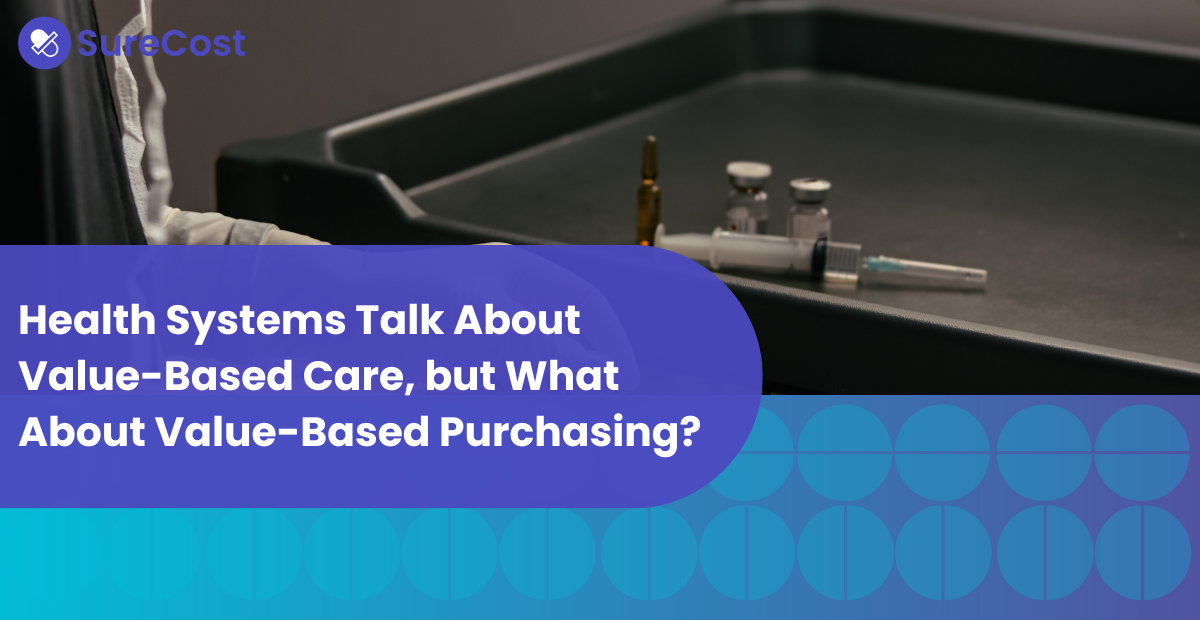Drug shortages are nothing new to the pharmacy industry. But as the industry grows more complex and global events shape the supply chain, they’re becoming a huge pain point across all classes of trade. And they’re not going away any time soon.
The impact may vary, but drug shortages can affect patients’ health, your pharmacy operations and your business’s bottom line. Pharmacies can’t afford to merely react to drug shortages. In this article, we’ll chart the causes and impact of drug shortages before showing you how you can anticipate, compensate and mitigate when drug shortages hit.
The Roots of Drug Shortages
Unsurprisingly, many drug shortages can be traced back to low supply from the outset. Some manufacturers might not expend the resources to produce low-margin drugs, meaning there’s just a handful of companies supplying those products. And if a manufacturer producing one of those low-margin drugs gets shut down by the FDA or initiates a recall, negative impacts quickly trickle down.
As we saw during the COVID-19 pandemic, even with regular supply, demand for certain prescription items can rapidly increase past production capacity and immediately spike major drug shortages. This may lead to greater reliance on imported products. But because the FDA doesn’t have as much oversight when it comes to offshore manufacturers’ processes, those imports can’t make it to market as expediently as domestic drugs (if they make it at all).
Overseas volatility can further impede the supply chain and lead to shortages of raw ingredients needed to make these products domestically. Some pharmacies may then stockpile products, which exacerbates the effects of shortages on pharmacies that weren’t lucky enough to get their share of the supply.
The Impact on Patients, Staff and Your Business
Of course, drug shortages mean patients can’t get their medications. That affects a pharmacy professional’s primary obligation: the patient’s health. Beyond not receiving that medication, persistent drug shortages can also impact the patient’s treatment. If a patient tells their doctor they can’t find their prescription anywhere, that doctor may prescribe another drug that, while clinically coordinated, could still have unanticipated short- or long-term side effects.
In addition to consequences for the patient’s health, there may be huge financial impacts due to drug shortages. Shortages lead to high demand that drives up prices. There’s no guarantee an alternative drug will be comparable in price or covered by the patient’s insurance. And even if the alternative is readily available, its price may also skyrocket. In any of these situations, patients may be forced to choose between their physical or financial well-being.
A patient’s level of confidence in their pharmacy also suffers. They’re already dealing with a medical issue. They don’t want to worry about getting the medicine they need. Consistent inability to supply prescriptions may cause patients to go to another pharmacy, which in turn impacts your pharmacy’s revenue. If the patient stays with your pharmacy but can’t afford the medication, you may end up with a product you can’t dispense and incur the charge.
Seeing this impact on patients leads to frustration and desperation among pharmacy staff. In a retail setting, where you’re seeing patients face-to-face, you’re experiencing the individual’s concerns on a daily basis. At an LTC pharmacy, you may encounter the same feelings from nurses and doctors calling to check for updates. In an acute care setting, the issue is even more severe: medical staff will feel the pressure to deliver the care they need to while also dealing with patients and their families, and they’ll start knocking on the pharmacy’s door. If the drug is needed for a procedure, a shortage can lead to delays and an uncomfortable call from a surgeon.
On top of the damage to patient service and your bottom line, the scramble to find the right drugs at the best prices and field concerns from patients and medical staff consumes hours of time. Pharmacy staff are stretched thin enough when there’s enough products available. Anything you can do to alleviate these pressures will benefit everyone.
Spot Shortages in Advance
Pharmacy professionals can’t do much to prevent drug shortages. Fortunately, there are strategies and tools to anticipate these shortages and stop them from impacting your patients.
It starts with building a network of subject matter experts. Check the FDA’s drug shortage database for updates and alerts that signal a potential shortage. The Associated System of Health Pharmacists (ASHP) has a fantastic resource center for drug shortages. If you’re searching for vaccines, you’ll probably find the most up-to-date shortage information from the Centers for Disease Control and Disease Prevention (CDC) current vaccine and delays shortage page.
You can also look to secondary vendors who specialize in getting ahead of shortages. Are they buying up a particular product? For example, if they have a significant offer on an item based on having excess, they may be anticipating a spike in demand. Also, larger health systems and chain pharmacies may see a shortage first in a particular geographic region, for example, locations closer to the manufacturer. They shouldn’t assume one or two pharmacies are the exception to a shortage; they could just be early signals that the rest of their chain could adapt, prepare and help each other out with.
At the same time, this is not an exact science. A potential shortage is not the same as an actual shortage, which may never arise. Beware of initiating a large purchase at the first sign of a possible shortage. A manufacturer, for example, could amp up production to avoid that scenario, and you’ll have taken an unnecessary risk that leads to products expiring on your shelf unsold.
Build Foundations to Weather Shortages
These strategies, along with knowledge of your own needs, can help you foresee shortages. Next, you’ll want to lay the groundwork to compensate for shortages—which comes down to flexibility and a good network.
If you’re reliant on one wholesaler and they can’t supply, a shortage is the worst time to search for and set up new vendor accounts. Having more than one vendor agreement in place, including access to specials and negotiated prices, means you’ll be selecting options during a stressful period (not ironing out new contracts).
Pharmacies should also integrate clinical decision makers ahead of shortages or other emergencies. In a retail setting, if you have several doctors in your area prescribing the same drug, you can let them know you’re encountering shortages with those products. That will help those doctors offer alternatives in advance. It also shows your commitment to the patient’s care and your community.
At hospitals, your clinical partner may be the Pharmacy and Therapeutics Committee charged with ensuring the best clinical outcomes for the lowest costs. They work with both medical and pharmaceutical staff to analyze insurance carriers’ coverage and generate a corresponding formulary to prescribe medications. Working with a committee like this, together you can create a decision tree for providers to recommend alternatives in the event of a shortage. Good planning can go a long way toward reducing everyone’s stress and securing the patient’s needs.
At LTC pharmacies, get advice from your clinical pharmacist. They’re on the ground daily in facilities and likely in the best position to help manage providers’ expectations. Lean on their advice and prepare your order entry teams to head off unnecessary back orders piling up.
Mitigate the Effects of Drug Shortages
Unfortunately, even the most prepared pharmacy will have to deal with shortages. That means minimizing the impact. The first and best tool to mitigate the effects of drug shortage is accurate usage data. If you don’t know how much you’re going through, then you won’t see how short you could be. With that information, you can lay the groundwork for that mitigation based on your true need.
Alongside that data, you’ll want to build your network further so you have dedicated resources for finding the products. Even without a designated purchasing staff, “go-to” contacts and back-up vendors set you up for proactive measures (rather than waiting for standard channels to supply the products or respond to your inquiries).
A system to track your usage and record your dispense volume is crucial here. Don’t leave this up to manual processes or a single purchaser’s intuition. An integrated solution for purchasing and inventory consolidates the data, allows easy reporting and provides a single source of truth (even if your purchaser is out sick or a vendor only tracks usage for products you purchased from them).
Integrating all purchases through a single solution—no matter how many secondary vendors you’ve added to expand your purchasing options and including service providers like GPOs—allows you to find the right option quicker and more efficiently. When shortages hit, experienced buyers know they need to place their purchase orders fast.
By placing all your orders for all vendors through one interface, you’re getting in line even as you send several orders. You won’t be comparing separate catalogs or uploading multiple purchase orders after spending hours hunting down that drug or an alternative. Instead, it’s all there in a single system. You can also program auto-reorders to keep requesting that product until it’s filled. You’ll also have a history if that vendor fails to supply, which may prompt you to investigate other trader partners once the dust settles.
By tracking usage history to compare against what’s on your shelves now, you’ll keep your inventory lean and up-to-date by ordering exactly what you need when you need it. With an expanded purchasing portfolio, even in the face of shortages, you may be able to find enough of the product to meet your actual dispense patterns. And the best systems will help you manage transfers so you use your own stock across multiple locations for replenishment.
Best-in-class purchasing and inventory management enhances your search and reduces the stress. For example, if you’re looking for a specific NDC and find low stock from your wholesaler, you can configure the system to show you the best alternative based on price, compliance and other selected variables. You’re averting a last-minute scramble (and might want to research to see if there’s a shortage on the horizon).
Equip Your Pharmacy Team to Thrive in the Face of Drug Shortages
Drug shortages have major consequences for your patients, their medical providers, your staff and your business. Strategies to anticipate them and mitigate their effects are essential to maintain your relationships and your business. With the right strategies and tools combined with a level of informed vigilance, pharmacies can respond to drug shortages without feeling the pressure.
Patients will know they can still rely on you even when you’re in the hot seat for drug shortages. Medical providers will know you’re working diligently to track down what your patients need. And staff will trust that you’ve done the work to make their job easier and ensure they can effectively serve the patient.
Learn More About Withstanding Drug Shortages
If you are interested in learning how SureCost can help your pharmacy withstand drug shortages and save more, work smarter and stay compliant, book a meeting today with one of our experts.








.png)